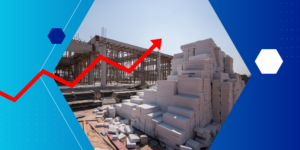
Construction input prices have now increased by 20.1% in the last 12 months — and are currently 46% higher than they were in the months leading up to the pandemic. And last month, construction costs continued to rise: Prices increased 1.9% from May to June, according to a recent report by The Association of Builders and Contractors (ABC).
This inflationary trend has hammered contractors for the last couple of years, but economists are starting to see signs of a cooldown. While cheaper materials prices might provide some immediate relief for contractors, it’s too early to say what effects a possible recession might have on the construction industry as a whole.
Since early 2020, the effects stemming from the COVID-19 pandemic have wreaked havoc on global supply chains while simultaneously contributing to increased demand for certain construction services, such as housing. As a result, the construction industry has dealt with huge price increases that have generally outpaced normal consumer inflation.
Check up-to-date materials prices for lumber, cement, & more with the Construction Materials Price Tracker tool.
Other factors, such as the ongoing war in Ukraine, have also contributed to price disruptions. Energy costs saw large increases last month, with natural gas prices jumping over 24% since May.
The industry hasn’t seen price increases like this since the 1970s, and contractors across the country have faced project disruptions and cash flow instability as a result.
“It’s no secret that contractors and their customers have been walloped by massive increases in construction materials prices,” said Anirban Basu, Chief Economist at the ABC. Basu also noted that contractors have reported lower profit expectations as prices continued to increase last month.
However, signs of a slowdown are finally starting to appear. Of the 11 subcategories of nonresidential construction materials measured in the US Bureau of Labor Statistics’ Producer Price Index, four actually saw prices decrease from May to June. The price of lumber, which has fluctuated wildly over the past couple of years, dropped by nearly 25% last month alone.
“More recently, key commodity prices have declined, so it may be possible we have achieved peak inflation,” continued ABC’s Basu. “Indeed, with much of the world at risk of recession, there is likely to be further downward pressure on commodity prices going forward.”
“To secure work and to induce project starts, a growing fraction of contractors is having to trim margins.”
– Anirban Basu, Chief Economist, The Association of Builders and Contractors
After months of an overheated economy, many economists are now predicting a recession is on the horizon. While nothing is certain, it’s possible that hard-hit contractors may continue to face a bumpy road for some time.
“In the context of rising fears of recession and rising borrowing costs, the stage has been set for softer nonresidential construction activity going forward,” said Basu.
The ABC also reported recently that construction professionals’ expectations of profit margins fell last month to levels not seen since October 2021.
“For months, contractors expected sales, employment and margins to expand,” wrote Basu. “The most recent ABC survey indicates that, to secure work and to induce project starts, a growing fraction of contractors is having to trim margins.”
Despite these fears, the ABC expects the industry overall to continue to see growth over the next six months — due largely to the influx of federal spending on public projects.
“Public contractors can expect to remain busy in the context of a significant infrastructure spending package,” said Basu. The Biden Administration’s recently passed $1 trillion federal infrastructure bill was projected to create millions of jobs, revitalize the country’s infrastructure, and provide a major boost to the construction industry.
But other industry leaders such as The Association of General Contractors of America (AGC) warned last week that it will be increasingly hard for the industry to handle all sorts of public infrastructure projects — if prices continue to rise.
“The more materials prices increase, the harder it will be for public officials to build new schools, roads and other infrastructure,” said Stephen E. Sandherr, CEO of the AGC. “Taking steps to address rising materials prices will help construction employers and taxpayers alike.”
While some materials are getting cheaper, it’s clear there is still plenty of price volatility across the industry: “Some materials prices have fallen recently but others appear headed for further increases,” said Ken Simonson, Chief Economist for the AGC.
“In addition, the supply chain remains fragile and persistent difficulties filling job openings mean construction costs are likely to remain elevated despite declines in some prices,” Simsonson said.
The AGC has lobbied the Biden administration to remove tariffs on construction materials wherever possible and to seek ways to alleviate the continued pressure on supply chains.
If inflation really is plateauing, declining materials prices may provide some needed relief for contractors — but it’s still too early to predict the full impact of a possible recession on the demand for construction services.